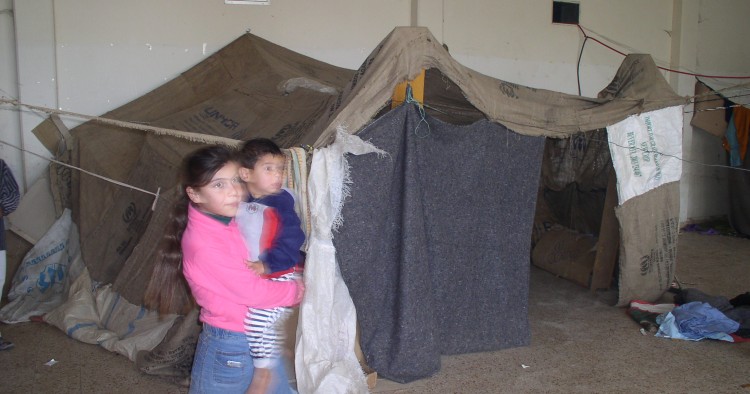Originally posted July 2008
Most of those writing about future scenarios for Iraq rarely mention the fate of the 5 million displaced Iraqis, but when they do, they seem to assume that once security and political progress in Iraq are achieved, the refugees and internally displaced persons (IDPs) will return to their communities and life will go on. Unfortunately, even in the best of political scenarios, it is unlikely to be so straightforward. The lessons learned from recent returns of Iraqis to their communities — though the number is very small, less than 1% of displaced Iraqis — provide an inkling of what is likely to come if conditions in Iraq improve.
From September-November 2007, there were enthusiastic reports that refugees were returning from Syria to Baghdad.1 The Iraqi government and coalition forces interpreted this as evidence that the ‘surge’ was successful and that security was improving. The Baghdad government organized a convoy of buses to bring the Iraqis home, offered those returning to Baghdad an $800 cash incentive, and heralded the returns as the beginning of a new era. But the government soon backtracked and suggested that the Iraqis not come home until later, the $800 inducement was dropped, and no further bus convoys were organized. Since then, the United Nations High Commissioner for Refugees (UNHCR) consistently has refused to recommend that Iraqis return to Iraq. While there have been some modest refugee returns and larger numbers of IDPs returning to their communities in 2008, the numbers are still small.2
But the little we know about the returns raises troubling possibilities of what is to come. Even in the positive scenario that improvements in security continue and political progress is made, many concerns arise. First, indications are that most of the refugees who have returned so far have done so because of economic hardship and visa restrictions in Syria. The “push” factor seems stronger than the “pull” factor. Secondly, virtually all of the return movements have been to areas that have become ethnically/religiously homogeneous. Returnees move primarily to those neighborhoods under the control of members of their sect. Only a few families have returned to areas under the control of another sect. In its 2007 survey, UNHCR found no members of minority groups (Christians, Sabaean-Mandeans, or Yazidis) who had returned.3 Moreover, there are few mixed neighborhoods to which Iraqis can return. This seems to suggest that future patterns of Iraqi returns will bolster sectarian separation, reinforcing the trends of the weakening of religious pluralism in Iraq and the rise of a society where sectarian identity is competing with national identity.
A third troubling aspect of the returns thus far is the specter of conflicts over housing, land, and property. An estimated 70% of returning refugees and 55% of returning IDPs have found their property destroyed, damaged, or occupied by others.4 As I have previously argued,5 the issue of property claims could well be a ticking time bomb, which could renew conflicts. Furthermore, the need to establish mechanisms to resolve property disputes and to enforce those decisions for hundreds of thousands — possibly millions — of claims will be a major undertaking.
A fourth troubling aspect of the returns thus far is the message they have given to European governments hosting Iraqi refugees and asylum-seekers. European governments — most notably Sweden and the United Kingdom — have announced that they will begin returning Iraqis whose claims for asylum have been denied.6 There is also concern that the return of a limited number of Iraqi refugees could shift attention away from the ongoing needs of Iraqis living in neighboring countries. If donor governments were to perceive that the refugee problem is over because people are going back, they will be less likely to fund humanitarian programs for Iraqi refugees in Iraq’s neighboring countries. There is evidence that this year — for the first time in the last few years — UNHCR is facing difficulties in getting the necessary support for its Iraqi programs. If refugees do not receive the necessary assistance in exile, the pressure will increase on them to return before conditions are conducive to repatriation, which could well put additional burdens on a still very fragile state.7
In the best case, the level of violence in Iraq will decrease, political institutions will function more effectively, security will improve, and international organizations will provide greater humanitarian assistance inside Iraq. In this case, refugees and particularly IDPs will try to return. However, it is likely — and indeed desirable — that returns take place over several years. If the returns were to occur suddenly, there would be a risk of further instability as a result of overwhelmingly inadequate infrastructure and the prospect of simultaneously dealing with a large number of property disputes.
A basic principle of durable solutions for both refugees and IDPs is that decisions to return must be voluntary, which means that IDPs must have a choice between alternatives. The question of alternative solutions is particularly important for refugees who are unlikely to be able to return to Iraq, including minorities, female-headed households, and serious medical cases. Support for host governments to allow these groups to integrate locally would thus be important.8 In addition, this should be complemented by a robust resettlement program to the US, which would demonstrate a shared commitment to finding solutions for the refugees. For IDPs, the option of settling in another part of the country should be provided.
While improved security is key to the return of refugees and IDPs, it is important to underscore the need for good governance in planning for sustainable returns. Even if violence decreases, if people cannot receive their food rations or find a job, if there are no doctors or functioning schools, if they do not trust the local police, if they cannot get compensation for property now occupied by others, they will not return. If they are forced to return, they could well be a further de-stabilizing force. Present trends indicate that security is improving and that progress is being made on the political front. If these trends continue, refugees and IDPs will return. However, according to a recent survey, a majority of those displaced indicated that they plan to stay where they are, and only 17% indicated that they plan to return to their community of origin.9
If the security situation does not continue to improve, then the prospects for Iraq’s refugees and internally displaced are grim indeed. A deteriorating situation in Iraq could result from a change in loyalties of Sahwa (also called “Awakening”) groups, the ending of the al-Sadr ceasefire, or increasing intra-Shia violence. If sectarian and other violence worsens, if power devolves to local militias, if there is little political process, the already fragile infrastructure is further damaged, and displacement increases, then large-scale voluntary returns are unlikely, and, in fact, it is probable that many of those who are displaced within the country may try to move to other countries. However, they are unlikely to find a positive reception by host governments already concerned about the impact of the large numbers of Iraqi refugees.
1 See for example, Albert Aji, “Buses bring hundreds of Iraqis home,” The Washington Post, November 27, 2007.
2 UNHCR estimates returns during the second half of 2007 and the first three months of 2008 to stand at 50,000 refugee returns and 60,000 IDP returns. UNHCR projects that overall in 2008, there will be 100,000 newly displaced; 100,000 refugee returns and 120,000 IDP returns. UNHCR, “Progress on Mainstreaming IDP issues in UNHCR and Global Work Plan for IDP Operations,” EC/59/SC/CRP.16 (June 2008), p. 23.
3 UNHCR, UNHCR Second Rapid Assessment of Return of Iraqis from Displacement Locations in Iraq and from Neighbouring Countries, March 2008, http://www.reliefweb.int/rw/RWB.NSF/db900SID/SHIG-7CEDPJ?OpenDocument.
4 Julien Barnes-Dacey and Sam Dagher, “Returning from Syria, Iraqis question safety,” Christian Science Monitor, November 28, 2007, http://www.csmonitor.com/2007/1128/p06s01-wome.htm; IOM, Returnee Monitoring and Needs Assessments, IOM/MoDM, Baghdad, January 2008
5 Elizabeth G. Ferris, “The Looming Crisis: Displacement and Security in Iraq,” Foreign Policy at Brookings, Policy Paper, July 2008.
6 Alan Travis, “Iraqi asylum seekers given deadline to go home or face destitution in UK,” The Guardian, March 13, 2008, p. 4.
7 Peter Grier, “How will the Iraq war end?” Christian Science Monitor, March 13, 2008, http://www.csmonitor.com/2008/0318/p01s05-woiq.html.
8 For example, of the 204,000 Iraqis registered in Syria, 11% were found to have experienced torture or violence in Iraq and around 15% were found to have a serious medical condition. UNHCR, “Syria Update,” May 2008.
9 UNHCR, IOM, UNOPS, MoDM, KRG, “Socio-economic conditions of internally displaced persons and their intentions,” 2008.
The Middle East Institute (MEI) is an independent, non-partisan, non-for-profit, educational organization. It does not engage in advocacy and its scholars’ opinions are their own. MEI welcomes financial donations, but retains sole editorial control over its work and its publications reflect only the authors’ views. For a listing of MEI donors, please click here.












